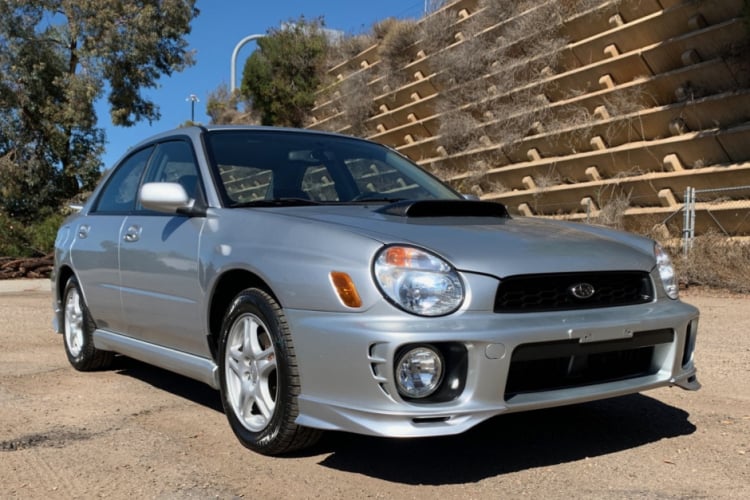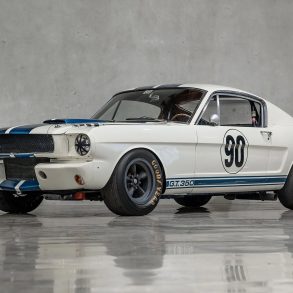The Subaru WRX is an automotive legend. It’s the rallying car of choice for the World Rally Championship (WRC). Here’s the second generation WRX story, from the Bugeye to the Blobeye and the Hawkeye.
The Subaru WRX (standing for ‘World Rally eXperimental’) exploded on the car scene in 1992, immediately becoming one of the most sought-after, enthusiast performance cars.
Combining the practicality of a four-door body, power of the turbocharged, flat-four engine, and incredible road holding provided by Subaru’s signature all-wheel-drive system, the Impreza WRX has become a proper modern classic and unbeatable rally monster.
Although it wasn’t the first turbocharged and AWD model ever made, Subaru WRX’s affordable price, dependable mechanics, and enormous tuning potential made it the favorite everyday performance car for millions of fans worldwide.
Today, we will discuss the similarities and differences of three well-known and well-loved second generation WRX’s models: the Bugeye, the Blobeye, and the Hawkeye, produced between the 2000 and 2007 model year.
Subaru WRX Bugeye (2000 to 2003)
Introduced in 2000, the Subaru WRX soon gained the affectionate nickname “Bugeye” for its characteristic round headlights and front fascia body style. Available as a sedan or station wagon, WRX was based on the second-generation Impreza model and offered globally, including the USA, which proved to be one of its biggest markets. This model was presented with a five-speed manual or four-speed automatic, but the manual was the only choice for true car aficionado.

The power came from a 2.0-liter, turbocharged flat-four engine, which developed 218 horsepower and 292 Nm of torque. Of course, as with all WRX models, this flat-four unit was highly tunable, and the majority of owners decided to upgrade their cars to more power and performance. The Bugeye stayed in production until 2003, during which time around 40,000 examples were sold globally.
What Year was the WRX Bugeye?
The Bugeye WRX was constructed from 2000 to 2002 as the second generation Subaru Impreza.
How much is a Bugeye WRX?
The average value for a manual transmission Bugeye WRX sedan is $12,500. Concours condition will attract prices near $27,000, with fair condition cars selling for only around $6,300. Automatic transmission vehicles sell for about 15% less and WRX wagon sell slightly cheaper.
Subaru WRX Blobeye (2003 to 2006)
Introduced in late 2003, the Blobeye was a redesign version of the Bugeye WRX, with the new front fascia, front and rear bumper, and headlights (hence the name). Although most car fans think that Blobeye was just a second facelift to keep the WRX looking fresh and updated, the truth is that Subaru did, in fact, did some modification by slightly upgrading the engine and mechanics.


The 2003 to 2006 Subaru WRX kept the 2.0-liter flat-four engine but delivered a few more horsepower than the predecessor. The power output was 225 hp and 300 Nm of torque; however, the overall performance was unchanged.
What year was the Blobeye WRX?
The Blobeye WRX debuted at the end of 2003.
How much is a Blobeye WRX?
The average value for a manual transmission Blobeye WRX sedan is $11,500. Concours condition will attract prices near $25,700, with fair condition cars selling for only around $5,800. Automatic transmission vehicles sell for about 15% less and WRX wagon sell slightly cheaper.
Subaru WRX Hawkeye (2006 to 2007)
After just three years on the market, Subaru decided to improve the WRX model again by introducing a second and final restyle, which was available for only one model year.

Called “Hawkeye” for its sloped and more aggressive front-end design and headlights, this was a further enhanced driving machine. However, the modifications weren’t only on the surface, and Hawkeye god a significantly larger engine and more power.
Subaru introduced 2.5-liter, flat-four engine in 2005, offering it on WRX STI models. However, from 2006 all WRX models received this powerplant which produced more power and torque in stock form and had even better tuning potential. The nominal power output was 230 hp and 320 Nm of torque which improved performance and top speed.
What year is the WRX Hawkeye?
The Hawkeye WRX debuted in 2006 and production only continued until 2007.
How much is a Hawkeye WRX?
The average value for a manual transmission Blobeye WRX sedan is $11,500. Concours condition will attract prices near $25,700, with fair condition cars selling for only around $5,800. Automatic transmission vehicles sell for about 15% less and WRX wagon sell slightly cheaper.
The difference in Appearance of the Subaru WRX Bugeye, Blobeye, and Hawkeye
As you probably know, the main visual difference between those three models is their front end. We are not talking just the headlight design, but the whole front fascial esthetics. However, several body parts are interchangeable between the Bugeye, Blobeye, and Hawkeye; the front end parts are not. Each distinctive generation has a specific hood, front bumper, fenders, and of course, headlights.
The rear end is the same, although there are some differences in taillight design as well as in spoilers and trim. The interiors are the same, but some models (depending on the market) can have a higher level of interior equipment and different dashboard illumination.
Difference in Performance
Even though we are talking about very similar cars, both in terms of power and weight, there is a significant difference in performance between them. In fact, the difference between the Bugeye and Blobeye is minimal, but the Hawkeye, with its bigger and more potent engine, has a clear advantage over the earlier models.
The official 0 to 60 mph acceleration number for Bugeye WRX is 6.2 seconds with a top speed of 142 mph. Even though this vehicle is almost 20 years old, those are still respectable numbers.
The Blobeye WRX, with its slightly more powerful engine, is capable of reaching 60 mph in 6.0 seconds with a bit higher top speed of 144 mph. This improvement was the result of careful engineering and a small bump in power.
However, the Hawkeye WRX is the fastest, with a 0 to 60 mph time of just 5.8 seconds. Interestingly, according to factory data, the Hawkeye is slower than the Blobeye at 142 mph, probably due to revised gear ratios installed for better acceleration.
Of course, we are talking about completely stock and unmodified examples. Once those cars reach tuner hands, they are turned in blisteringly fast street races which could outrun even the latest supercars.
Difference In Availability Of Parts
Since all three models were mass-produced and relatively common, the availability of spare parts (new and used) is generally considered very good. However, there are few things you should consider.
The earlier models (Bugeye and Blobeye) are slightly cheaper to maintain since the 2.0-liter engines are deemed more reliable and robust.
The 2.5-liter engine in Hawkeye is known for having problems on high-mileage examples, which could be costly to sort. Also, since the 2.0-liter engine is more common, parts are somewhat cheaper.
The suspension parts (brakes, A-arms, sway bars) are practically identical between all three models. As we said before, some bodywork components (doors, trunk cover) are interchangeable, and most interior pieces can be mounted on either generation without any problem.
Images Source: Bring a Trailer










